Greetings! I'm Aneesh Sreedharan, CEO of 2Hats Logic Solutions. At 2Hats Logic Solutions, we are dedicated to providing technical expertise and resolving your concerns in the world of technology. Our blog page serves as a resource where we share insights and experiences, offering valuable perspectives on your queries.

QUICK SUMMARY
- If you’re on Shopify/Shopify Plus: Consider Hydrogen first, then Next.js
- If you’re on WooCommerce: Next.js or Nuxt.js are your best bets
- If you’re on BigCommerce: Their Next.js starter kits offer the smoothest path
- If performance is your top priority: React Storefront or SvelteKit
- If SEO dominates your strategy: Gatsby or Next.js
- If development speed is critical: Vue Storefront or Hydrogen
Remember that the best headless frontend framework is ultimately the one that aligns with your team’s skills, your business requirements, and your commerce backend.
Are you feeling lost in the sea of frontend options for your headless commerce project?
When our team at 2HatsLogic started building headless storefronts, we spent countless hours testing different frameworks, hitting unexpected roadblocks, and wishing for a straightforward guide that cut through the marketing hype. That’s what we will share with you today.
Having helped dozens of brands transition from traditional monolithic platforms to modern headless architectures, we have seen which headless frontend frameworks truly deliver and which ones create more problems than they solve.
Let’s dive into the frameworks that actually work in real-world headless commerce implementations.
Understanding Headless Commerce Backends Before Choosing a Frontend
Before we explore frontend frameworks, let’s quickly understand the major commerce backends they’ll connect to:
Shopify: Works with Hydrogen & Storefront API
Shopify Plus: Enterprise-grade with additional API capabilities and higher rate limits
WooCommerce: Uses REST API or GraphQL with custom frontends
BigCommerce: Designed for headless from the start
Your choice of backend will influence which frontend framework makes the most sense for your project.
Not sure which commerce backend is right for you?
What Makes a Great Headless Commerce Frontend Framework?
When evaluating frontend frameworks for headless commerce, look for these key attributes:
- Performance: Fast loading and rendering capabilities
- Commerce-specific features: Built-in cart, checkout, and product display components
- Backend compatibility: Strong integration with your chosen commerce platform
- Developer experience: Robust documentation and active community
- Scalability: Ability to handle growth in traffic and catalog size
Best Frontend Frameworks for Headless Commerce
Now, let’s explore the seven frameworks that excel in these areas.
1. Next.js
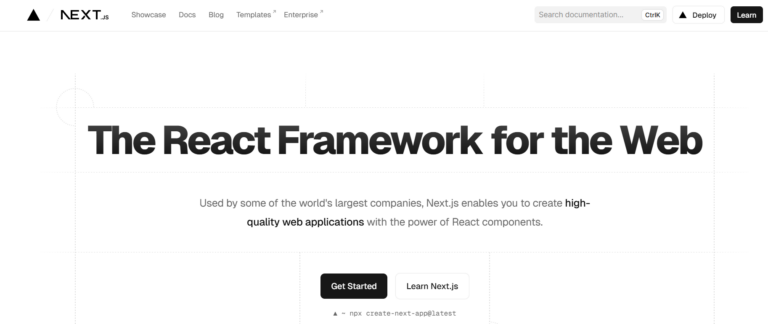
Next.js has emerged as the go-to framework for headless commerce implementations—and for good reason. Built on React, one of the most popular modern frontend libraries, it combines developer flexibility with production-grade performance.
Why It Stands Out:
- Flexible rendering options including server-side rendering, static generation, and incremental static regeneration
- Seamless integration with virtually any headless commerce backend
- Built-in image optimization crucial for product catalogs
- Robust routing for complex catalog structures
Real-World Example:
We recently migrated a client from a traditional Shopify theme to a headless architecture using Next.js connected to Shopify Plus. Their mobile conversion rate increased by 24% within the first month, primarily due to the improved performance and custom checkout flow we implemented.
Best For:
Next.js works exceptionally well with Shopify Plus, BigCommerce, and virtually any other commerce backend with a solid API.
2. Hydrogen
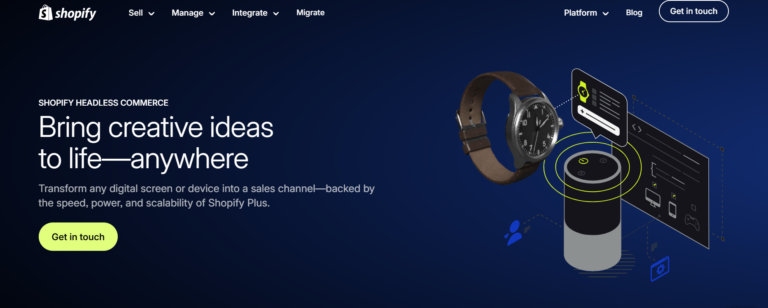
As Shopify’s purpose-built headless frontend framework, Hydrogen deserves special consideration if you’re in the Shopify ecosystem.
Why It Stands Out:
- Deep integration with Shopify’s Storefront API
- Commerce-specific React hooks that simplify development
- Server components for improved performance
- Oxygen hosting optimized specifically for Hydrogen stores
Who Should Use It:
Hydrogen is the natural choice for Shopify and Shopify Plus merchants looking to go headless while maintaining the benefits of the Shopify ecosystem.
Running a Shopify store? Discover if Hydrogen is right for you.
3. Vue Storefront
Vue Storefront stands out as a framework built specifically for headless commerce rather than being a general-purpose framework adapted for commerce.
Why It Stands Out:
- Pre-built commerce components for carts, product displays, and more
- Multi-backend support including BigCommerce, Shopify, and WooCommerce
- PWA capabilities out of the box
- Headless CMS integrations for content-rich storefronts
Best For:
Vue Storefront excels for teams familiar with Vue.js who want to fast-track development with commerce-specific components.
Pro Tip: When evaluating frameworks for your specific needs, build a simple product detail page as a test. This single-page type exercise most critical commerce features: image galleries, variant selection, pricing display, and add-to-cart functionality.
4. Gatsby
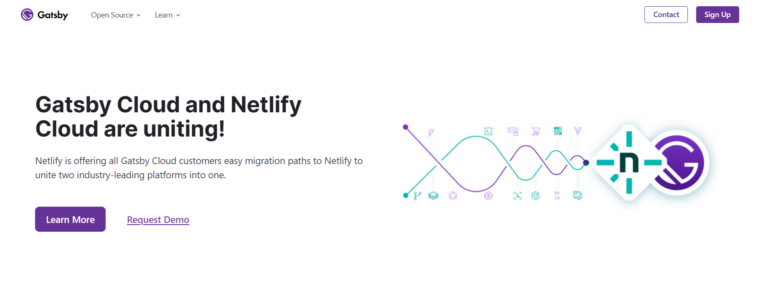
While it’s lost some momentum to Next.js in recent years, Gatsby remains an excellent choice for content-rich headless commerce sites where SEO is paramount.
Why It Stands Out:
- Static site generation creates lightning-fast experiences
- Superior image optimization is built into the core
- Rich plugin ecosystem for commerce and SEO
- GraphQL data layer makes it easy to pull and transform product data
Best For:
Gatsby works well with any commerce backend that offers a solid API, including WooCommerce, BigCommerce, and Shopify.
| Framework | Initial Load Speed | SEO Benefits | Development Speed | Best Backend Pair |
|---|---|---|---|---|
| Next.js | Fast | Excellent | Medium | Any (versatile) |
| Hydrogen | Very Fast | Good | Very Fast | Shopify/Shopify Plus |
| Vue Storefront | Fast | Good | Fast | Multiple |
| Gatsby | Very Fast | Excellent | Slower | Content-heavy stores |
5. React Storefront
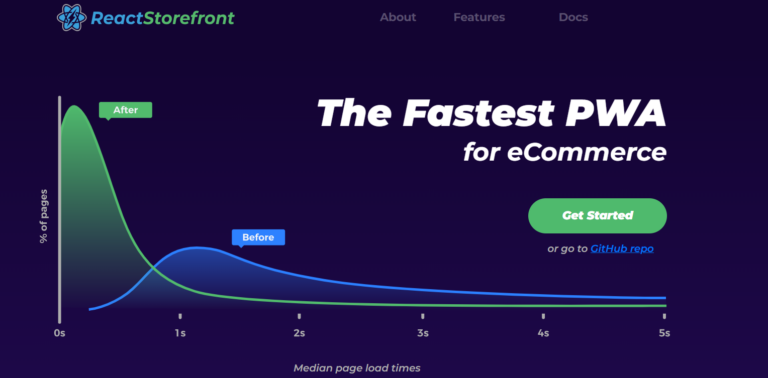
React Storefront focuses specifically on solving the performance challenges that plague many e-commerce sites.
Why It Stands Out:
- Sub-second page loads even on mobile networks
- AMP support for product and category pages
- Sophisticated caching that dramatically improves performance
- Built-in A/B testing capabilities
Best For:
React Storefront pairs well with any backend with a robust API, including BigCommerce and Shopify Plus.
6. Nuxt.js
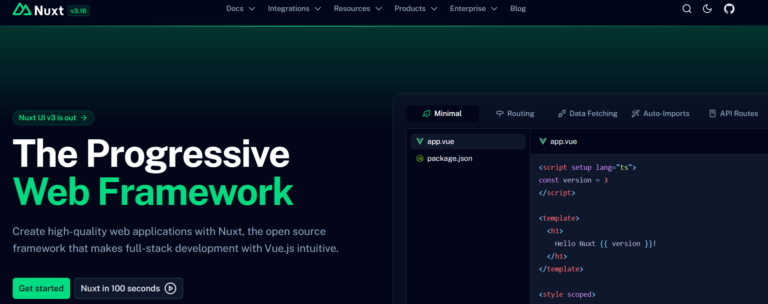
If your development team prefers the Vue ecosystem, Nuxt.js offers powerful capabilities similar to Next.js for building headless commerce experiences. It’s especially well-suited for Shopware, and we’ve done extensive work using Nuxt as the Shopware storefront, delivering fast, engaging, and highly customizable user experiences.
Why It Stands Out:
- Vue-based components with a gentler learning curve for many
- Automatic code-splitting for improved performance
- Server-side rendering or static generation options
- Growing commerce module ecosystem
Best For:
Nuxt.js works well with any commerce backend, but we’ve had particular success pairing it with WooCommerce for mid-sized stores.
7. SvelteKit
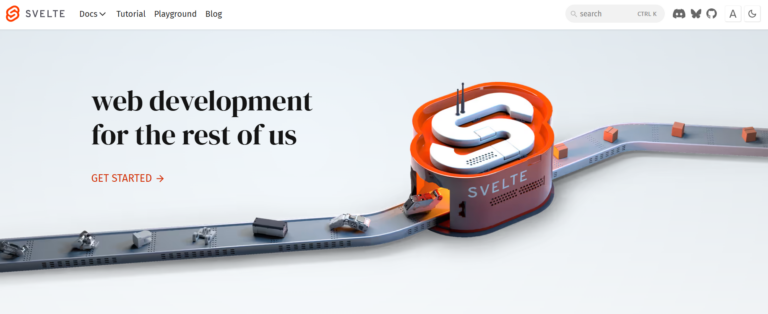
Although newer to the headless commerce scene, SvelteKit is gaining traction for its exceptional performance characteristics.
Why It Stands Out:
- Minimal runtime code resulting in tiny bundle sizes
- True reactivity without virtual DOM overhead
- Flexible rendering options similar to Next.js
- Simple but powerful state management ideal for cart functionality
Best For:
SvelteKit works with any commerce backend with a solid API, though we’ve primarily used it with Shopify and BigCommerce.
Pro Tip: When building a headless commerce store, focus first on the core user journey (browse, search, add to cart, checkout) before adding advanced features. A smooth basic experience beats a buggy advanced one every time.
Choosing the Right Framework for Your Commerce Backend
Different backends pair better with certain frontends:
Shopify and Shopify Plus
Best frontend options:
- Hydrogen – The official solution with the deepest integration
- Next.js – The most popular alternative with excellent Shopify integrations
- React Storefront – For performance-critical Shopify stores
WooCommerce
Best frontend options:
- Next.js – Most mature ecosystem for WooCommerce headless
- Nuxt.js – Great for teams with Vue experience
- Gatsby – Excellent for content-rich WooCommerce stores
BigCommerce
Best frontend options:
- Next.js – BigCommerce has excellent Next.js starter kits
- Vue Storefront – Official integration available
- SvelteKit – For maximum performance
Real-World Considerations Beyond the Framework
Having implemented dozens of headless commerce projects, we can tell you that the frontend framework is just one piece of the puzzle. Other critical considerations include:
- Content management – How will you handle non-product content?
- Search functionality – Most headless projects require a dedicated search solution
- Performance optimization – Framework choice impacts this, but there’s more to it
- Authentication – How will customer accounts work in your headless setup?
- Analytics – Tracking user behavior across a decoupled architecture
Conclusion
Ready to start your headless commerce journey but not sure which framework is right for your specific needs? At 2HatsLogic, we specialize in helping brands navigate these technical decisions and then implementing them flawlessly. Reach out today, and let’s build something amazing together.
FAQ
What exactly is a headless commerce frontend framework?
A headless commerce frontend framework is a development framework that allows you to build the customer-facing part of your online store (the "head") separately from your e-commerce platform's backend.
How long does it take to launch a headless commerce site?
A typical timeline ranges from 2-4 months for a straightforward implementation to 6+ months for complex enterprise stores. The timeline depends on factors like the complexity of your catalog, custom features needed, and integration requirements.
Can I keep my existing commerce platform when going headless?
Yes! That's one of the biggest advantages. You can keep using Shopify, WooCommerce, or BigCommerce for your product management, inventory, and order processing while creating a custom frontend experience. No need to migrate your data or learn new backend systems.
Table of contents

Related Articles






